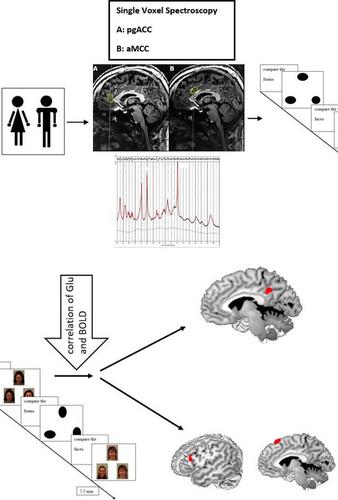当前位置:
X-MOL 学术
›
Eur. J. Neurosci.
›
论文详情
Our official English website, www.x-mol.net, welcomes your
feedback! (Note: you will need to create a separate account there.)
Local glutamate in cingulate cortex subregions differentially correlates with affective network activations during face perception.
European Journal of Neuroscience ( IF 2.7 ) Pub Date : 2020-04-16 , DOI: 10.1111/ejn.14733 Dominik Denzel 1 , Lejla Colic 1, 2 , Liliana Ramona Demenescu 1 , Felicia von Düring 1, 3 , Inka Ristow 1, 3 , Hanna Nießen 1 , Luisa Hermann 4 , Jörn Kaufmann 5 , Udo Dannlowski 6 , Jörg Frommer 7 , Matthias Vogel 7 , Meng Li 1, 8 , Anton Lord 9, 10 , Martin Walter 1, 2, 4, 8, 11, 12, 13
European Journal of Neuroscience ( IF 2.7 ) Pub Date : 2020-04-16 , DOI: 10.1111/ejn.14733 Dominik Denzel 1 , Lejla Colic 1, 2 , Liliana Ramona Demenescu 1 , Felicia von Düring 1, 3 , Inka Ristow 1, 3 , Hanna Nießen 1 , Luisa Hermann 4 , Jörn Kaufmann 5 , Udo Dannlowski 6 , Jörg Frommer 7 , Matthias Vogel 7 , Meng Li 1, 8 , Anton Lord 9, 10 , Martin Walter 1, 2, 4, 8, 11, 12, 13
Affiliation

|
The cingulate cortex is involved in emotion recognition/perception and regulation. Rostral and caudal subregions belong to different brain networks with distinct roles in affective perception. Despite recent accounts of the relevance of cingulate cortex glutamate (Glu) on blood‐oxygen‐level‐dependent (BOLD) responses, the specificity of the subregional Glu levels during emotional tasks remains unclear. Seventy‐two healthy participants (age = 27.33 ± 6.67, 32 women) performed an affective face‐matching task and underwent magnetic resonance spectroscopy (MRS) at 7 Tesla. Correlations between the BOLD response during emotion perception and Glu concentration in the pregenual anterior cingulate cortex (pgACC) and anterior midcingulate cortex (aMCC) were compared on a whole‐brain level. Post hoc specificity of the association with an affect was assessed. Lower Glu in the pgACC correlated with stronger activation differences between negative and positive faces in the left inferior and superior frontal gyrus (L IFG and L SFG). In contrast, lower Glu in the aMCC correlated with BOLD contrasts in the posterior cingulate cortex (PCC). Furthermore, negative face detection was associated with prolonged response time (RT). Our results demonstrate a subregion‐specific involvement of cingulate cortex Glu in interindividual differences during viewing of affective facial expressions. Glu levels in the pgACC were correlated with frontal area brain activations, whereas Glu in the salience network component aMCC modulated responses in the PCC–precuneus. We show that region‐specific metabolite mapping enables specific activation of different BOLD signals in the brain underlying emotional perception.
中文翻译:

扣带回皮层子区域中的局部谷氨酸与面部感知期间的情感网络激活差异相关。
扣带回皮层参与情绪识别/感知和调节。鼻部和尾部子区域属于不同的大脑网络,在情感感知中具有不同的作用。尽管最近有关于扣带回皮层谷氨酸(Glu)与血氧水平依赖性(BOLD)反应的相关性的报道,但在情感任务过程中该次区域Glu水平的特异性仍不清楚。72位健康参与者(年龄= 27.33±6.67,32位女性)执行了情感面部匹配任务,并在7特斯拉接受了磁共振波谱(MRS)。在全脑水平上比较了情感感知过程中的BOLD反应与前扣带前皮层(pgACC)和扣带前皮层(aMCC)中的Glu浓度之间的相关性。评估了关联与情感的事后特异性。pgACC中较低的Glu与左下和上额回(L IFG和L SFG)的负脸和正脸之间较强的激活差异相关。相反,aMCC中较低的Glu与后扣带回皮质(PCC)中的BOLD对比度相关。此外,负面的面部检测与延长的响应时间(RT)相关。我们的研究结果表明,在观察情感性面部表情时,扣带回皮层Glu在个体间差异中有特定区域的参与。pgACC中的Glu水平与额叶脑部激活相关,而显着网络成分aMCC中的Glu调节PCC-足突中的反应。我们显示出特定于区域的代谢物图谱可以使潜在情感感知大脑中的不同BOLD信号发生特定激活。
更新日期:2020-04-16
中文翻译:

扣带回皮层子区域中的局部谷氨酸与面部感知期间的情感网络激活差异相关。
扣带回皮层参与情绪识别/感知和调节。鼻部和尾部子区域属于不同的大脑网络,在情感感知中具有不同的作用。尽管最近有关于扣带回皮层谷氨酸(Glu)与血氧水平依赖性(BOLD)反应的相关性的报道,但在情感任务过程中该次区域Glu水平的特异性仍不清楚。72位健康参与者(年龄= 27.33±6.67,32位女性)执行了情感面部匹配任务,并在7特斯拉接受了磁共振波谱(MRS)。在全脑水平上比较了情感感知过程中的BOLD反应与前扣带前皮层(pgACC)和扣带前皮层(aMCC)中的Glu浓度之间的相关性。评估了关联与情感的事后特异性。pgACC中较低的Glu与左下和上额回(L IFG和L SFG)的负脸和正脸之间较强的激活差异相关。相反,aMCC中较低的Glu与后扣带回皮质(PCC)中的BOLD对比度相关。此外,负面的面部检测与延长的响应时间(RT)相关。我们的研究结果表明,在观察情感性面部表情时,扣带回皮层Glu在个体间差异中有特定区域的参与。pgACC中的Glu水平与额叶脑部激活相关,而显着网络成分aMCC中的Glu调节PCC-足突中的反应。我们显示出特定于区域的代谢物图谱可以使潜在情感感知大脑中的不同BOLD信号发生特定激活。











































 京公网安备 11010802027423号
京公网安备 11010802027423号